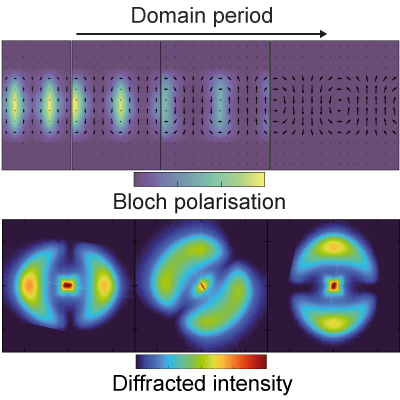Physics Department News
New paper published in Physical Review X
Dr Marios Hadjimichael has published a paper in Physical Review X titled 'Assessing the ubiquity of Bloch domain walls in ferroelectric lead titanate superlattices.'Link opens in a new window
A team of researchers from the European Synchrotron Radiation Facility (ESRF), the Czech Academy of Sciences, Université de Liège, University of Geneva, and the London Centre for Nanotechnology led by Marios have used advanced theoretical and experimental techniques to address the nature of nanoscale domain walls in ferroelectrics, materials that possess a switchable spontaneous polarisation. They have found that, although these types of domain walls can possess their own ferroelectric polarisation with Bloch-type character akin to ferromagnetic systems, their precise nature is more complex and depends on the boundary conditions at their interfaces.
Building upon their theoretical insights, the team proposed a novel technique based on X-ray diffraction to probe the internal structure of domain walls. They demonstrated the capability of this technique to detect nanoscale rotations of spontaneous polarization at these boundaries, consistent with their theoretical predictions. This study shows that the behaviour of ferroelectric domain walls in these systems is much more complex than originally thought, and heterostructures must be carefully tailored to utilise the expected complex polarisation rotations for future applications in nanoelectronics. The work emphasises the potential of X-ray diffraction as a suitable tool for studying domain walls in various ferroelectric materials, inspiring future studies that will use this method to determine the structure of nanoscale domain walls in other systems.
Marios says: “Our collaborative work has established an impressive agreement between theory and experiment, further advancing these techniques for the characterisation of nanoscale ferroelectric systems. We are looking forward to applying our guidelines based on X-ray diffraction to a range of materials that can exhibit complex polarisation rotations at boundaries between domains. This will allow for the discovery of new phases in ferroelectrics and the development of systems where the internal structure of their domain walls can be utilised in applications in nanoelectronics.”

The image shows the following: Top panel: simulations of the polarization distribution (arrows) in ferroelectric superlattices consisting of lead titanate and strontium titanate. The colour bar denotes the axial Bloch polarisation that disappears as the lateral size of the domains increases. Bottom panel: diffuse X-ray scattering measurements taken at beamline ID01, showing anisotropic scattering consistent with the flux-closure configuration above.
Physical Review X journal publishes ground-breaking and impactful research in Physics.
